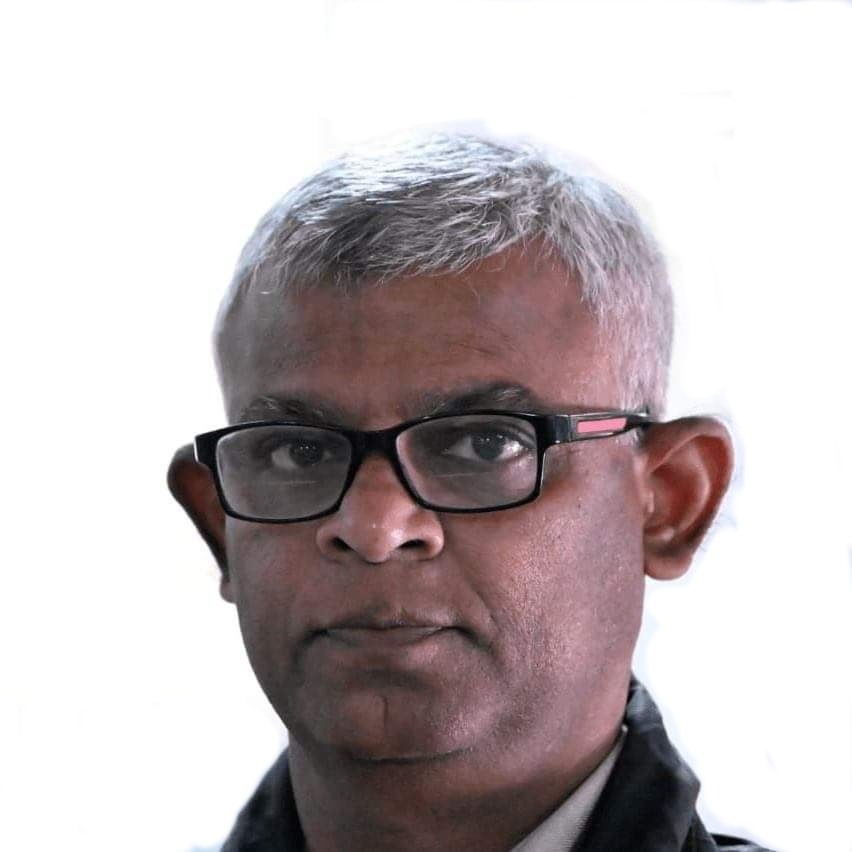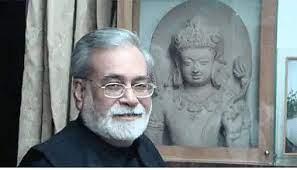( Birth Anniversary )

Niraj Krishna
Modern Tulsi, Dr. Narendra Kohli, always asserted that literature should always be inclined towards a positive aspect because the depiction of lowly occupations will lead to degradation and a rise in baseless sentiments. The goal of literature should be to portray the sublime, great, and virtuous aspects of life.
Narendra Kohli was not just a writer associated with politics but also an author for readers. His novel series “Mahasamar,” based on the Mahabharata after the Ramayana, was embraced by a large section of Hindi society. During the era when television broadcasts of “Ramayana” and “Mahabharata” were prevalent, Narendra Kohli’s novels also reached every household. He once said that I do not regret not being able to become Sachin Tendulkar, because I know that Tendulkar can never become Narendra Kohli. No one can be made a writer, writers are born.
In the period when there was a debate about Hindi readers shifting towards television, Narendra Kohli’s novels kept readers connected to books. It is essential to conduct a comprehensive study of the fact that during the 1990s, when Hindi literature was contracting, with major Hindi publications closing or losing their influence, Narendra Kohli established a distinct genre in Hindi literature. He gave new forms to mythological narratives and sparked new debates around them. It’s not that there was no writing on myths in Hindi before Narendra Kohli, or that he wasn’t connected to contemporary references. Examples like Dharmveer Bharati’s ‘Andha Yug’ can be cited. However, the uniqueness of Narendra Kohli lies in his perception of these narratives as a tradition, a tradition that remained strong even in contemporary contexts.
Coming from undivided Punjab to Hindustan, Narendra Kohli spent a significant part of his life in undivided Bihar in the city of Jamshedpur. He always had a small-town perspective within him, and perhaps that’s why he connected so well with small-town readers, continuing to write for them throughout his life.
Born on January 6, 1940, in Sialkot, Punjab (now in Pakistan), Narendra Kohli, despite having a passion for reading and writing, faced challenges due to his father’s eye ailment and could only study up to the eighth grade in school. The manuscripts of his three or four novels written in Urdu were left as a legacy for his writer son. He worked as a temporary clerk in the Forest Department of undivided Punjab. After the partition of the country, due to a lack of capital, degree, and other skills, he was compelled to sell fruits on the streets of Jamshedpur. Later, with the help of his son Narendra Kohli, he opened a small shop in the Sakchi area, where he conducted regular business until his death in 1985.
After the partition in 1947, the family moved to Jamshedpur (Bihar). Narendra Kohli received his early education at New Middle English School in Jamshedpur. He continued his studies from the eighth to eleventh grade at the Mrs. K. M. P. M. High School, run by the TISCO company. So far, the medium of instruction for all his education was Urdu.
For higher education, he joined the Jamshedpur Co-operative College. In 1961, he moved to Delhi for B.A. (Hindi) from Jamshedpur Co-operative College. In 1963, he passed the M.A. examination in Hindi literature from Ramjas College, Delhi University. He also obtained a Ph.D. from the same university in 1970.
Dr. Narendra Kohli served as a Hindi professor at P.G.D.A.V. College in Delhi. He began his second job at Motilal Nehru College in Delhi in 1965 and concluded his career on November 1, 1995, after taking voluntary retirement after 55 years of service. Since then, he has depended on his pension and writing. During this time, he married Dr. Madhurima Kohli, who was appointed as a lecturer in the Hindi department of Kamala Nehru College at Delhi University in 1964.
His first published work appeared in the handwritten magazine of the sixth grade. In the eighth grade, a story titled “Hindostan: Janat Nishaan” was published in the school’s printed magazine. His interest in writing in Hindi began during high school, and some early writings were published in magazines like Kishor (Patna) and Awaaz (Dhanbad). During his undergraduate studies, a story titled “Paani Ka Jag, Gilaas Aur Ketli” was published in the new Ankur column of Sarita (Delhi).
Regular publications began in February 1960, marking the commencement of his writing career. Therefore, he considers his first published work, “Do Haath” (Story, Allahabad, February 1960), as significant.
Around 1965, he started writing satire. His language became witty, and he began addressing the issues of society and politics. His writings from that time reflected his views on the inhumanity, cruelty, and lack of logic in social and political life. The entire genre of Hindi satirical literature attests to the fact that there is no creativity, diversity, and brilliance like his in his generation. He was not satisfied with mere social commentary and mockery of absurdities and distortions. He wanted to do something meaningful. He realized that literature cannot achieve its perfection through limited and brief portrayals of life; nor can society benefit more from it. Depicting lowly professions will only increase inferiority and lowly feelings. Therefore, the aim of literature is to portray the lofty, noble, and virtuous aspects of life.
Narendra Kohli wrote an epic novel of 1800 pages in four volumes, taking material from the Ramayana. Perhaps, this is the first novel written in any language that encompasses the entire Ramayana. It is contemporary, progressive, modern, and logical because it is a novel. Its foundational material is drawn from India’s cultural tradition, presenting a portrayal of life’s elevated values, human greatness, and the boundlessness of life. Like a Hindi reader, awakened from a deep sleep, he shook off his cultural and intellectual dualities. He found answers to his profound questions and solutions to his doubts. This creation received an unprecedented welcome, and the direction of the stream of Hindi novels changed. The new ground of the Ramayana was presented in a new and modern way in terms of humanity, reliability, physicality, social, political, and modern aspects. Scholars such as Acharya Hazari Prasad Dwivedi, Amritlal Nagar, Yashpal, Jainendra Kumar, and others have praised Narendra Kohli in explicit terms.
Jainendra Kumar says, ‘I do not know what expectations one has from a novel and what its art is. It seems that his creation rises above the novel’s religion and goes up to the class of some scriptures with great skill.’ Bhagwati Charan Verma writes, ‘I have seen the talent in Narendra Kohli that makes him one of the leading Hindi authors. He has presented with great skill some parts of the Ramayana with (‘Diksha’). There is fictionality in it, a grip on the story.’ Yashpal states that Narendra Kohli has made an effort to provide a realistic and logical interpretation of the Ramayana, which many historians consider only as a myth. It is a good attempt to make the myth of Ahilya a reality through imagination. Hazari Prasad Dwivedi writes, ‘Narendra Kohli has seen the Ramayana with an entirely new perspective in ‘Avsar.’ The character of Sita portrayed in it is very attractive. Sita has never been depicted in such a radiant form. At the same time, the character of Sumitra has been presented as a very radiant woman.
Dr. Nagendra writes, “Initiative has been taken to provide a contemporary context to the Ramayana based on mature reflection in Diksha.” The main events of Balakanda and the characterizations of Rama and Vishwamitra are retold with a rational reinterpretation, offering specific achievements in the form of Ram’s role as the Yugapurush/Yugavatar. Dharmaveer Bharati writes, “Out of curiosity, I turned some pages of ‘Diksha’, and then the book introduced itself in such a way that I finished it by reading it all evening. The complete Ramayana in four parts is a significant project. The side stories of Sita and Ahilya have become very powerful in this.
Poet Baba Nagarjun writes, “Now a name has been added to the list of some first-class novelists – Narendra Kohli, to whom I want to convey my appreciation firmly.” He mentions that various characters related to the Ramayana have emerged in new forms, and their perspectives in the narrative will anchor the principles of justice within each reader.
Renowned poet Shivmangal Singh ‘Suman’ states that such a contemporary interpretation of the Ramayana had never been read before. This provides a healthy perspective of understanding Rama on the human plane, replacing mere emotionalism with the reality of struggle. The interpretation is remarkably fresh, and the traditional dignity of the Ramayana has been preserved.
Narendra Kohli initiated the creation of his new novel “Mahasamar” based on the Mahabharata narrative. Mahabharata is an epic that presents Indian life, philosophy, and behavior in a concrete form. Kohli has brought this epic to life in his era, presenting life with its complete magnitude. In this novel, he presents life with its complete magnitude. He provides solutions to questions related to real-life experiences and reasoning. In this epic, you will read about Mahabharata and rise with the understanding of your own life. Characters like Yudhishthira, Krishna, Kunti, Draupadi, Balarama, Arjuna, Bhima, and Karna are presented in extremely novel forms; however, Kohli’s authority lies in portraying these characters in their true essence in the Mahabharata.
Readers must definitely read two works of Narendra Kohli – firstly, “Abhigyan” (a novel), where a touch of politics is made centering around Krishna. When the powerful Lord Krishna accepts the impoverished and insignificant Sudama as his friend publicly, Sudama’s influence rises immediately in social, business, and political fields. This work doesn’t deal with afterlife, heaven, or hell. The principle of karma is explained on this earth under one life, based on knowledge, senses, and intelligence, in accordance with scientific principles. It is marvelous and unprecedented. You cannot ignore his other masterpiece, ‘Todo Kara Todo’ – a creation centered around Swami Vivekananda. It can truly be said that such priceless creations are written only once.
Kohli deserves credit for giving a grand status to his novels as well. He has dispelled the myth spread in Hindi society that there are no readers in Hindi, or Hindi readers are poor, or they do not have time to read. Multiple editions of his invaluable books have been printed, and even today, Kohli’s novels are in great demand among readers.
There is no doubt that Dr. Narendra Kohli holds a special place among Indian authors, and his identity in Hindi literature is unmatched as a unique storyteller who has presented mythological characters in a new light and a new perspective. Narendra Kohli was not against the fusion of cultures, but he did not tolerate any kind of distortion in language. He was the most modern writer of ‘tradition,’ yet he remained a writer whose tradition was not established. Dr. Narendra Kohli was such a linguistic yogi who, through his writings, defined the legacy and rich traditions of this soil in contemporary contexts.


